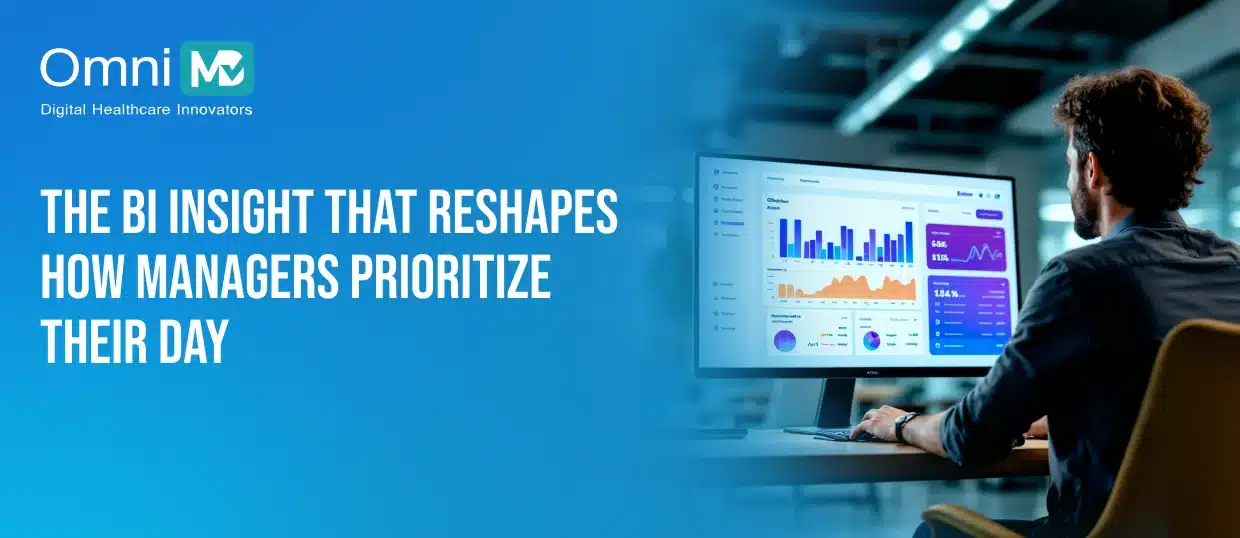How BI Helps Practice Managers Make Faster, Better Decisions
Practice managers make roughly 120 to 180 operational decisions each day. That is about 15 to 22 decisions per hour in a busy clinic. These decisions cover scheduling, staffing, room utilization, patient flow, insurance coordination, documentation readiness, and financial oversight. Decision science defines this as high-density decision-making, where the volume of choices exceeds the brain’s natural capacity for structured analysis.
A person can maintain only 4 to 7 items in working memory. For a practice manager, that translates into managing 40 to 70 active variables within the first few hours of operations. These variables span appointment lengths, authorization statuses, payer requirements, clinician documentation progress, inventory levels, and patient flow velocity. Once the variable set surpasses cognitive capacity, structured reasoning gives way to intuition, effective in predictable settings but vulnerable in healthcare’s constant variability.
This variability makes operational decision-making in clinics a complex cognitive challenge. Healthcare systems produce nonlinear effects. A shift in patient arrivals alters room utilization. A documentation delay slows billing. A payer rule change affects collections. A schedule adjustment impacts clinical throughput. Each element influences others, not as isolated functions but as nodes within a dynamic network.
Because of this interdependence, having more data does not automatically mean better decisions. What matters is coherence. Data that connects across systems and reveals consistent patterns. Without coherence, decisions are fast but fragile, shaped by surface signals instead of underlying truths. With coherence, decisions become fast and resilient because they mirror the system’s true behavior.
This is the point where Business Intelligence redefines the decision-making landscape.
However, BI did not begin as the sophisticated analytical ecosystem we know today. Its evolution mirrors the increasing complexity within clinics, an evolution worth understanding before exploring how BI supports practice managers now
Why BI Became an Operational Necessity
The earliest stage of Business Intelligence in healthcare resembled reporting more than intelligence. During this phase, BI primarily involved transaction logs, static performance summaries, ad hoc spreadsheets, and volume-based reporting. These reports answered what happened, not why it happened or what should happen next. They delivered insights only after the fact, often too slowly to match the tempo of clinical operations.
Clinic operations, meanwhile, began accelerating. Regulatory changes intensified. Patient expectations rose. Payer complexity multiplied. Operational friction expanded across departments. Clinics needed decisions that were both accurate and immediate. The growing complexity of these decisions called for systems capable of processing relationships far beyond human working memory.
This need pushed BI into its second phase.
Systems started consolidating data into structured repositories, allowing comparisons across time periods, providers, payers, and workflows. Data warehouses and ETL (extract, transform and load) pipelines became the backbone of this movement, with visualization tools turning static reports into interactive dashboards. This stage enabled practice managers to observe trends and correlations more clearly. Yet monitoring patterns still fell short of supporting real-time decision-making. Managers had to interpret signals manually, often under pressure to act quickly.
The third phase, modern BI, closes that gap.
Modern BI no longer serves as a rear-view mirror. It operates as a decision-making ecosystem that unites descriptive, diagnostic, predictive, and prescriptive analytics within everyday clinical workflows.
In this phase, BI:
- Maps interdependencies rather than isolated events.
- Reveals root causes instead of surface symptoms.
- Predicts operational strain instead of describing it afterward.
- Recommends actions instead of relying on individual interpretation.
- Aligns decisions with system dynamics instead of intuition.
Here’s how.
Business Analytics Collectively Reshaping How Practice Managers Perceive, Interpret, and Act Upon Information
Modern BI operates through a lifecycle consisting of:
- Data Warehousing
- Business Analytics
- Data Visualization
- Reporting and Action Delivery
Each stage directly influences the practice manager’s decision-making environment.
Data Warehousing Creates the Decision Foundation
At its core, a data warehouse is the practice manager’s most reliable decision substrate. It functions by extracting, transforming, and loading (ETL) data from every operational source such as EHR, practice management system, scheduling, billing, claims clearinghouse, laboratories, HR, and financial accounting.
This architecture consolidates disparate structures, relational databases, CSV exports, API feeds, into a central repository governed by standardized definitions. Within the warehouse, dimensional models such as star and snowflake schemas organize data around measurable business processes: appointments, claims, reimbursements, and encounters. Slowly changing dimensions preserve historical accuracy, allowing managers to analyze performance over time rather than through snapshots.
For the practice manager, this means every KPI, from room utilization to claims aging, stems from a controlled, verified data lineage. Without it, metrics drift depending on where they originate.
For instance, in one routine review, a practice manager notices patient wait times creeping upward. Initial instinct suggests higher patient volume. Yet when querying the warehouse, the integrated dataset reveals that documentation closure time increased for certain providers, elongating room turnover intervals. What appeared to be a volume problem turned out to be a workflow delay hidden between EHR timestamps and staff schedules.
The warehouse turns a fragmented data landscape into a coherent record of truth. It allows the manager to reason with precision rather than intuition, ensuring every subsequent BI layer, analytics, visualization, and reporting, rests on validated and standardized information.
Business Analytics Transforms Data Into Insight
Built upon the warehouse backbone, business analytics applies statistical, computational, and machine learning techniques to uncover meaning inside operational data. Analytical models calculate correlations, distributions, and predictive probabilities across the unified dataset, turning raw figures into structured insight.
For the practice manager, analytics is what converts “What happened?” into “Why did this happen, and what’s likely next?” It introduces tools such as:
- Descriptive analytics to summarize trends in productivity and throughput.
- Diagnostic analytics to trace root causes of inefficiency.
- Predictive analytics to forecast appointment cancellations, claim denials, or patient flow surges.
- Prescriptive analytics to recommend optimal staffing or scheduling patterns.
In a clinical set up, while analyzing appointment data, a manager might find that 12% of morning visits exceed scheduled durations. Regression results trace the issue to two providers and specific encounter types requiring additional charting. The model further quantifies the downstream consequences, delays in room availability and reduced afternoon throughput. What used to be uncertain now becomes measurable, actionable knowledge.
Analytics translates perception into structured understanding. It lets the practice manager evaluate decisions in the context of empirical probability rather than experiential assumption. Visualization then converts that numerical comprehension into immediate awareness.
Data Visualization Makes Patterns Immediately Recognizable
Data visualization acts as the interface between analytical complexity and managerial clarity. Visualization tools, like dashboards, interactive charts, and heat maps, query analytical models in real time and render the output visually through layers of aggregation and color coding.
For the practice manager, visualization creates immediate cognitive access. A heat map might depict patient queue velocity by color intensity, while line graphs show daily revenue trajectories. Geospatial views can highlight location-based discrepancies in provider utilization.
Technical design principles, such as responsive dashboards, pre-aggregated summary tables, and dynamic filters, ensure that visualizations load instantly and contextualize every figure.
Practically, a manager reviewing a queue dashboard may see the shift from green to orange as patient load builds in mid-morning hours. Rather than scanning spreadsheets, a single glance clarifies where congestion will peak, prompting timely staff reassignment. Underneath, cached summary tables and optimized SQL queries feed updated visualizations every few seconds—but what the manager experiences is clarity without computation.
Visualization converts complexity into shape and color. It shortens cognitive distance between analysis and action, ensuring that recognition happens early enough to influence outcomes. The next step delivers those insights directly into the practice’s operational flow.
Reporting and Action Delivery Embeds Intelligence Into Workflow
The final phase, reporting and action delivery, operationalizes intelligence. At this stage, BI systems integrate with practice management workflows to trigger alerts, push reports, and automate responses.
Behind the scenes, report schedulers query warehouse views at set intervals, generate formatted outputs, and deliver them through secure channels like dashboards, email, or EHR embedding. Event-driven scripts can listen for threshold breaches, such as cancellation probability above target, and issue real-time notifications via the PM or mobile app.
For the practice manager, this transforms BI from analytical support to operational partner.
Typical action delivery examples include:
- 9:00 AM predictive risk alerts for likely appointment cancellations.
- Automated daily RCM variance reports highlighting claim lag.
- Weekly KPI summaries showing provider-level throughput trends.
- Exception-based alerts when staff utilization exceeds thresholds.
These systems ensure that insight doesn’t wait for the manager to ask questions. Intelligence arrives when needed and where relevant, aligning decision timing with operational tempo.
This is to say, the warehouse guarantees truth, analytics finds meaning, visualization accelerates recognition, and reporting ensures action. Together, these mechanics reshape how practice managers perceive their data world, guiding every choice from staffing to revenue strategy through a foundation of structured, evidence-based intelligence.
Now, with the lifecycle established, the next layer leads us into the domain of data governance, the framework that preserves stability across the entire BI ecosystem.
Data Governance: The Anchor That Makes BI Trustworthy
Before a dashboard can be trusted and before analytics can be acted upon, the data itself must be stable, certified, and protected. This is the function of data governance, the discipline that ensures every data point powering BI is defined, validated, and managed with consistency.
For practice managers, governance is the difference between “I think this number is right” and “I know exactly what this number means, where it came from, and why I can rely on it.”
In a multi-system clinic environment, where EHR entries, billing codes, authorizations, and schedules change daily, governance establishes:
- Standardized definitions for clinical, operational, and financial metrics
- Certified data lineage that traces every KPI to its origin
- Data accuracy checks that catch anomalies before they distort insights
- Audit-ready processes built into the warehouse and integrated systems
- Security and compliance guardrails around every transformation
With governance, a provider-productivity metric means the same thing in a dashboard, in a revenue meeting, and in a performance review. Without governance, every department sees its own version of the truth, and BI collapses into debate instead of clarity.
Master Data Management (MDM): Eliminating Noise, Stabilizing Decisions
If governance sets the rules, master data management (MDM) enforces them in every system, every workflow, every report.
MDM harmonizes core reference data across the entire practice ecosystem:
- Provider and staff directories
- Payer and plan structures
- CPT/HCPCS/ICD service codes
- Patient demographics and identity attributes
- Location and department metadata
In the absence of MDM, the same provider might appear under three spellings, two departments might use different codes for the same service, and payer names may vary across clearinghouse files. The result?
With MDM, these foundational elements become single sources of truth. This reduces:
Reporting inconsistencies, claim mismatches, and operational errors.
- Claim denials caused by mismatched payer information
- Scheduling conflicts due to inconsistent provider availability
- Inaccurate KPIs caused by duplicate or misclassified entities
Access Control: Structuring Visibility for Better Decision Flow
Once data is governed and mastered, the next question is:
Who should see what, when, and why?
Access control structures how intelligence flows through the organization, ensuring insights are both secure and relevant.
It ensures that:
- The right teams receive the right insights at the right time
- Sensitive information stays protected
- Department workflows align with visibility
- Privileges match job responsibility
- No metric becomes misinterpreted due to context gaps
For a practice manager, this means dashboards load with the exact operational, staffing, and financial views necessary, nothing more, nothing less. Physicians see their own productivity trends, front-office teams see scheduling risks, and leadership sees consolidated enterprise-level insights.
What Makes OmniMD’s BI and Analytics Services Different?
Business Intelligence becomes valuable only when it works inside the flow of daily operations. Every insight in an OmniMD-powered environment starts with governed, consistent, and role-aligned data. The warehouse establishes a trusted foundation. MDM creates uniformity across providers, payers, and services. Access control guides information to the right teams with the precision required in clinical settings. These layers strengthen the entire BI lifecycle, ensuring that dashboards, models, and alerts reflect the clinic’s real behavior.
We deliver BI that moves with the pace of the clinic. Predictive alerts reach managers before strain develops. Performance views remain consistent across teams. Operational relationships become easier to understand. Instead of interpreting signals under pressure, managers receive intelligence that arrives ready for action. This structure gives practice managers confidence.
Confidence that every indicator follows a defined standard.
Confidence that trends align with actual workflows.
Confidence that decisions match the system’s true rhythm.

Turn Data Into Action With BI Insights
Unlock faster, smarter decision-making for your practice through real-time business intelligence dashboards.

 Written by Indravadan Gohil
Written by Indravadan Gohil